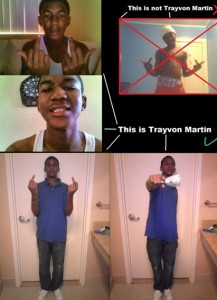What will it take for us to imagine Trayvon Martin as an innocent youth, gunned down for being black?
As everyone from the Florida State Attorney’s Office to the FBI endlessly weighs evidence, probability and possibility in this high-profile tragedy, I ask you: do you need to close your eyes and imagine Trayvon as a young white teen to see his innocence and to consider him worthy of simple justice?
New evidence in this tragedy seems to emerge every few days, sending all forms of media and experts into a race-drenched frenzy of analysis, pontification, and debate. A Time Magazine round-up of “The most relevant new pieces of information in the trial of George Zimmerman from the Florida special prosecutor’s new 183-page report” gives a few examples:
1. New video of Trayvon Martin before the incident doesn’t show any
aggressive behavior.
2. George Zimmerman’s injuries appear consistent with his claims to
police.
3. Martin was shot at close range.
4. There are so far no witnesses to the beginning of the
confrontation.
5. One witness said the fight had ended by the time the shot rang out.
6. George Zimmerman may have been profiling black males.
7. George Zimmerman was accused of having racist views.
8. Trayvon Martin had traces of THC in his blood.
9. Trayvon Martin may have been running from Zimmerman at first.
10. The lead investigator felt that there was enough evidence, based on
what he saw, to charge Zimmerman.
I propose that this case is not simply about whatever evidence is used to determine whether George Zimmerman goes to trial, and if so, the outcome of that trial. This case is really about the fact that black children in America have never been seen as innocent, as pure, as deserving of protection or worthy of justice.
This current discourse about Trayvon Martin reminds me of a scene from the movie, A Time to Kill, which I saw as a teenager. In that 1996 film, based on an earlier book by John Grisham, Tonya Hailey, a little black girl is viciously raped by two drunken white men who then commit several more acts of violence against her. The girl’s father, played by Samuel L. Jackson, is accused of murdering the men who raped his little girl, and goes to trial.
This excerpted version of the courtroom summation given by the father’s attorney, Jake Tyler Brigance, played by Matthew McConaughey, paints an unforgettable picture of what it takes for us to see black children in a different light:
“I want to tell you a story. I’m going to ask you all to close your eyes
while I tell you the story … about a little girl walking home from the
grocery store one sunny afternoon. I want you to picture this little girl.
Suddenly a truck races up. Two men jump out and … drag her into a nearby
field and they tie her up and they rip her clothes from her body … First
one, then the other, raping her, shattering everything innocent and pure
with a vicious thrust in a fog of drunken breath and sweat. And when
they’re done, after they’ve killed her tiny womb, murdered any chance for
her to have children, to have life beyond her own, they … start throwing
full beer cans at her … so hard that it tears the flesh all the way to her
bones. Then they urinate on her … They have a rope. They tie a noose.
Imagine the noose going tight around her neck and with a sudden blinding
jerk she’s pulled into the air and her feet and legs go kicking … The
hanging branch … snaps and she falls back to the earth. So they pick her
up, throw her in the back of the truck and drive out to Foggy Creek
Bridge. Pitch her over the edge. And she drops some thirty feet down to
the creek bottom below. Can you see her? Her raped, beaten, broken body
soaked in their urine, soaked in their semen, soaked in her blood, left to
die. Can you see her? I want you to picture that little girl. Now imagine
she’s white.”
Is that what it takes?
Do we have to close our eyes and change Trayvon’s skin to white to stop trying to make him out to be a huge, drug-addled threat to George Zimmerman rather than an innocent teenage boy walking home from a nearby store?
Even as a teen, younger than Trayvon was at the time of his murder, I knew that something was very, very wrong with the notion that the little black girl who had been so horrifically victimized could not be seen as innocent unless the jury pictured her as white.
Is there any hope of justice for black children if we cannot bring ourselves to imagine or see their inherent goodness and innocence beyond the projection of another identity? The notion of blackness as threatening, evil, dangerous, bad, guilty, and suspicious is so deeply ingrained into the American psyche that even in death, Trayvon cannot find sanctuary.
Even in death he is being demonized. Why else would the media and the experts make so much of the fact that he had marijuana in his system, or some marks or scratches on his hands? And if he had fought back, does that exonerate Zimmerman and justify the cold-blooded murder of an innocent and unarmed teenager?
In death, Trayvon is being portrayed as a man, as Zimmerman’s physical equal, so threatening that they’re scrambling to justify his murder. Why can’t we imagine Trayvon as frightened by a strange man tailing him in a car, and then jumping out of the car, armed with a weapon, to question his place? Why are we trying to criminalize the possibility that Trayvon might have fought back to defend himself against a stalking stranger?
Do we have to close our eyes to pretend that he was scared, vulnerable, under attack, innocent, that he had the right to bodily integrity, to stand his ground in the face of danger?
This scenario is not new.
During the Jim Crow period, in southern news reports of lynchings of black boys, city officials and the press often defensively “aged” adolescent and teenage victims in their descriptions. For example, the 14-year-old Emmett Till who was murdered in 1955 in Mississippi for whistling at a white woman, was described as “looking like a man” – an ironic reversal of the “boy” appellation given to black men.
Things haven’t changed. Jim Crow is gone. But today’s black parents still have to worry because Trayvon Martin is this generation’s Emmett Till, killed in his own suburban, gated community where he lived. Maybe the class status of some blacks has improved, but not the way in which their children are regarded.
If George Zimmerman goes to trial, will the prosecuting attorney have to follow the lead of the fictional attorney Jake Tyler Brigance from A Time Kill and ask the jury to close their eyes and imagine that Trayvon Martin was white for any chance of justice?



George Zimmerman’s life was in danger, and not from anything others might do but from the hatred he carried in his own heart.